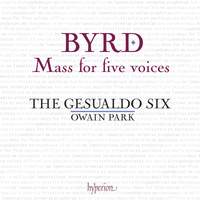Interview,
Owain Park on performing and dramatising Byrd's sacred music

In this 400th anniversary year, of course much musical energy is being focused on the works of William Byrd. Among those marking the occasion are The Gesualdo Six, and they're doing so in more ways than one; not only have they released a new album of Byrd's sacred music (built around his Mass for Five Voices, with a selection of motets, and ending with his gorgeous but relatively rarely-heard Lamentations), but they're also touring the country with an innovative new theatrical work that dramatises the experience of Byrd and his Catholic contemporaries under the suspicious gaze of English Protestantism.
The ensemble's Artistic Director Owain Park explains more about Secret Byrd, and considers what makes Byrd's music so uniquely appealing to both audiences and performes today.
You’re in the middle of your Secret Byrd tour, which sees you not merely performing Byrd’s Catholic-in-hiding music, but going far further down the reenactment route with a work of concert-theatre directed by Bill Barclay. How did this come about - how did you get on with wearing breeches...?
I remember my first conversation with Bill Barclay about Secret Byrd, which was a couple of years ago now. We met in an underground café, and within just a few minutes he had convinced me of his incredible storytelling power! Bill’s termed his work ‘concert-theatre’, with an equal focus on the visual audience experience as well as the sonic. The clothes we’re wearing vary from fairly standard period dress to rather shabby garments – it’s not meant to be glamorous, but to transport people back in time and encourage them to consider the circumstances in which Byrd found himself writing. His faith is well documented, but to bring the music to life in such an atmospheric candlelit setting is a magical experience and we look forward to many more concerts!
What sort of people did you attract - was it the same sort of music-lovers who would attend your more conventional performances, or did you find that theatrical approach connected with new audiences who wouldn’t normally have given Byrd a try?
Speaking to people after the show, it seems there is an interesting mix of early music fans, supporters of both Fretwork and G6, and those who find the historical angle intriguing. We welcome people before the show, and explain a little about what to expect. Audience members may be inclined to pick a chair and set up residence: the idea with this show is that everyone moves around, listening and watching from different points in the room to get a full (and unique) experience.
You also have a new recording of Byrd just out, centred around his Mass for Five Voices. Not to put too fine a point on it, but you’re the Gesualdo Six, not the Gesualdo Five! How well did Byrd’s five parts fit your six voices?
We performed the Byrd 5-part mass in our second concert, back in May 2014, and our approach is still the same: 5 singers, one to a part, and conductor. We perform Secret Byrd unconducted (from memory!), so for this recording, my job was to bring everyone’s musical ideas together into one cohesive whole. In our concerts, we often vary the texture: from intimate works in 3 parts, through to our full compliment of six voices. What works well about our line-up is that we have a lovely overlap between the voices, so that we can choose particular combinations for different works. On this album there is everything from close-knit 4-part writing with Ave verum corpus, through to expansive motets in 6 parts such as Afflicti pro peccatis nostris.
Some people prefer the Mass for Four Voices, which perhaps has more emotional intensity about it, to the Mass for Five Voices - though both are certainly major and important works in the repertoire. What do you think sets them apart from one another?
I find the Mass for four to be Byrd at his polyphonic best. It is an absolute gem, and graces any occasion where it’s sung. I remember working with a group of musicians in São Paulo who hadn’t encountered Byrd’s music before. We learned the Kyrie as part of a course on Renaissance polyphony, and performed it in the cathedral at São Paulo – perhaps the first time Byrd’s music had been sung there!
By contrast, I find the Mass for five more conversational and at times more intimate. Instead of intricate counterpoint, it deals in short motivic material that explores the expressive side of Byrd’s part writing. It’s glorious concert music, particularly for Secret Byrd, as we can explore these evocative lines as they are passed around the voices.
More generally - without of course wanting to dismiss the magnificent music of his contemporaries, there does seem to be something particularly special about Byrd’s music. Singers love it just as much as listeners do. What do you think the magic ingredient is?
We have always loved singing the music of William Byrd. He is a master of sculpture, who knows just when to tease the harmony unexpectedly, or create a moment of surprise. For singers, each line is focused and committed – it’s not easy music by any means, but we always find something new when revisiting each work. Thankfully it seems most of his music survives, unlike some of his contemporaries! We look forward to exploring much more of his writing over the coming years, and sharing it with audiences through concerts and our education programme.
Over the year the Gesualdo Six’s intimate and innovative performance of Byrd’s sacred music is also coming to Oxford, Bristol, Lammermuir, Brighton and York, plus a return to St Martin-in-the-Fields on 8 September for those in and around London who might have missed the January performances. More dates are planned; keep an eye on https://www.thegesualdosix.co.uk/secret-byrd/ for more information!
The Gesualdo Six, Owain Park
Available Formats: CD, MP3, FLAC, Hi-Res FLAC, Hi-Res+ FLAC



